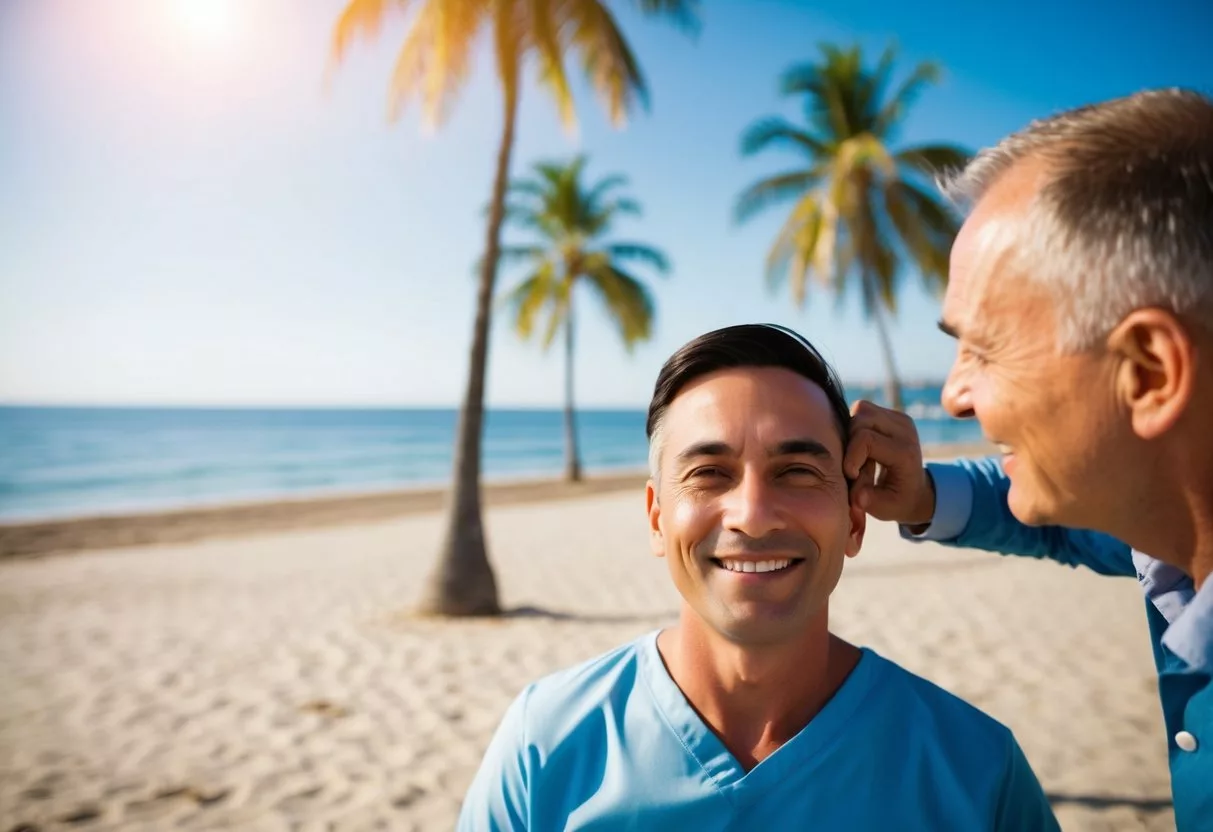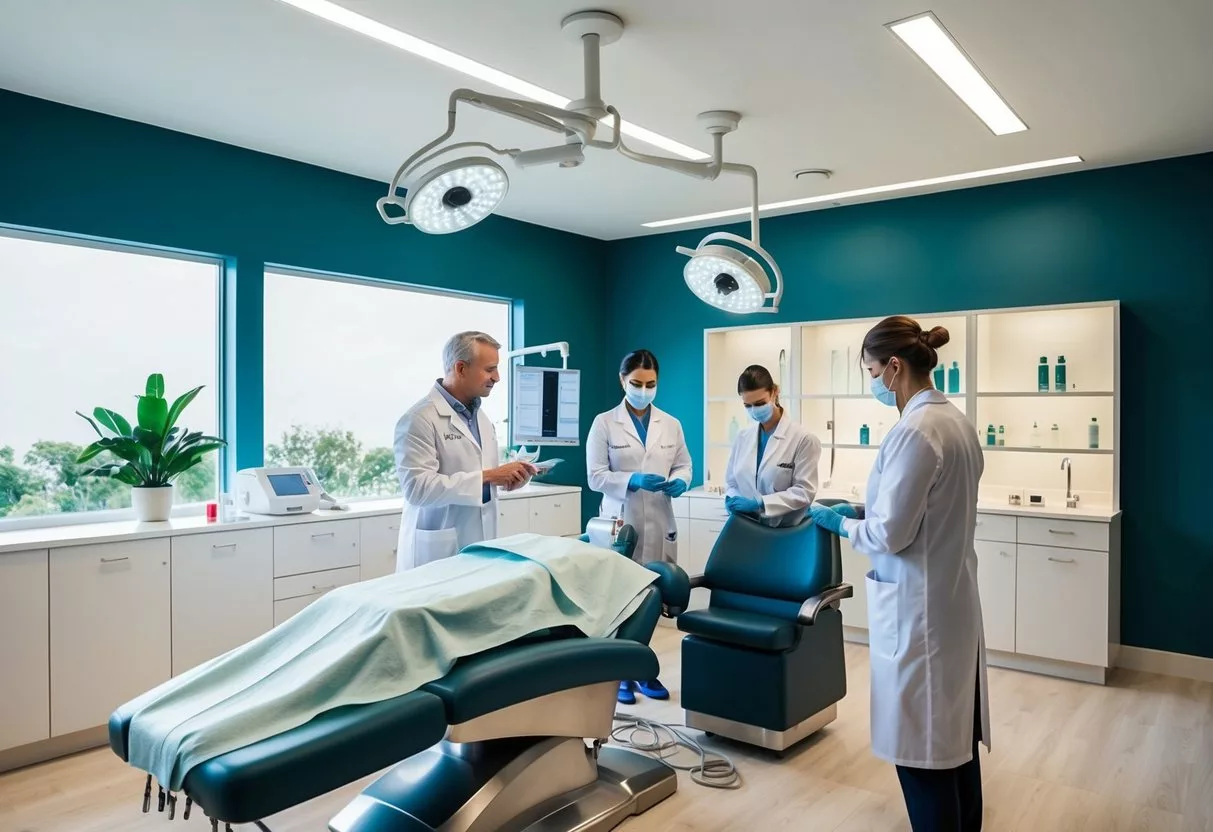Hair transplant tourism is gaining popularity as people seek affordable solutions for hair restoration. Many countries offer high-quality procedures at lower costs than in Western nations. This trend allows patients to combine medical treatment with a vacation experience.

Turkey, India, and Hungary are among the top destinations for hair transplant tourism, offering advanced techniques and experienced surgeons at competitive prices. For example, hair transplants in Turkey often cost between $1,500 to $3,000, much less than in Western countries. These savings can be significant, especially for those without insurance coverage for cosmetic procedures.
When considering hair transplant tourism, it’s important to research the clinic, surgeon credentials, and patient reviews. Follicular Unit Extraction (FUE) and Follicular Unit Transplantation (FUT) are two common techniques used in hair restoration. Patients should also factor in travel costs, accommodation, and follow-up care when budgeting for their procedure abroad.
Key Takeaways
- Hair transplant tourism offers cost-effective options for hair restoration in countries like Turkey, India, and Hungary.
- Advanced techniques such as FUE and FUT are available at many international clinics.
- Thorough research of clinics, surgeons, and patient experiences is crucial for a successful hair transplant abroad.
Understanding Hair Transplant Tourism

Hair transplant tourism combines medical care with travel. People go abroad for hair restoration procedures to save money and get high-quality treatment.
The Emergence of Medical Tourism in Hair Restoration
Hair transplant tourism started growing in the early 2000s. More people wanted to fix hair loss but found procedures too expensive at home. Countries like Turkey and India saw an opportunity. They built modern clinics with skilled doctors. These places offered hair transplants at much lower prices.
The internet made it easier for patients to find clinics abroad. They could read reviews and see before-and-after photos. This gave them confidence to travel for treatment. Many clinics started offering all-inclusive packages with hotels and airport pickups.
What Is Hair Transplant Tourism?
Hair transplant tourism means going to another country for hair restoration surgery. Patients travel to places known for good results and low costs. Popular spots include Turkey, India, and Thailand.
These trips usually last a few days. Patients get surgery and then stay for initial recovery. Many clinics use modern techniques like FUE (Follicular Unit Extraction). This method leaves minimal scarring and has a quicker healing time.
Medical tourists often combine their treatment with a vacation. They might see local sights before or after their procedure.
Benefits and Challenges of Hair Transplant Tourism
Benefits of hair transplant tourism include big cost savings. Prices can be 50-70% lower than in Western countries. Patients also get access to experienced surgeons who do many procedures each year.
Patient satisfaction is often high. Many report natural-looking results and good aftercare. Some clinics use the latest tech, giving results on par with top Western facilities.
But there are challenges too. Language barriers can cause misunderstandings. Follow-up care might be tricky once home. There’s also a risk of choosing an unethical clinic that cuts corners.
Patients must research carefully. They should pick accredited clinics and check surgeon credentials. It’s wise to have a local doctor for aftercare when they return home.
Evaluating Global Hair Transplant Destinations

Hair transplant tourism has grown in popularity. Patients seek quality care at affordable prices in different countries. Each destination offers unique benefits and specialties.
Turkey: A Leading Destination for Hair Transplant
Turkey stands out as a top choice for hair transplant procedures. Istanbul is home to many skilled surgeons and modern clinics. The country offers high-quality treatments at competitive prices.
Patients can expect to pay $1,500 to $3,000 for a full procedure in Turkey. This is much less than in Western countries. Many clinics provide all-inclusive packages with lodging.
Turkish doctors are known for their expertise in FUE (Follicular Unit Extraction) technique. They often have years of experience performing thousands of surgeries.
India’s Rise in Hair Transplant Services
India has become a popular destination for hair restoration. The country boasts skilled doctors and advanced technology. Indian surgeons are praised for their attention to detail.
Cost is a major factor drawing patients to India. Prices are often 60-70% lower than in the US or UK. Despite lower costs, the quality of care remains high.
Many Indian clinics use the latest techniques like robotic hair transplantation. They also offer personalized treatment plans for each patient.
Thailand and South Korea: Combining Tourism with Hair Restoration
Thailand and South Korea offer a unique blend of medical care and tourism. Both countries are known for their advanced medical facilities and beautiful attractions.
In Thailand, patients can enjoy tropical beaches while recovering from surgery. South Korea is famous for its cutting-edge beauty treatments and technology.
These countries provide high-quality care at moderate prices. They’re a good choice for those wanting to combine treatment with a vacation.
Spain, Mexico, and Hungary: Emerging Hotspots for Hair Treatments
Spain, Mexico, and Hungary are gaining recognition in hair transplant tourism. Each offers unique advantages to international patients.
Spain is known for its stringent medical standards and European-level care. Mexico attracts patients with its proximity to the US and affordable prices.
Hungary, especially Budapest, has become a hub for dental and hair restoration treatments. The country offers modern facilities and experienced doctors at competitive rates.
These destinations provide alternatives to more established markets. They often have shorter waiting times and personalized care.
The Hair Transplant Procedures Explained

Hair transplant procedures have evolved significantly over the years. Modern techniques aim to create natural-looking results with minimal scarring. The choice of method depends on factors like hair type, extent of hair loss, and desired outcome.
Follicular Unit Extraction (FUE): A Modern Approach
FUE is a popular hair transplant method. It involves removing individual hair follicles from the donor area, usually the back of the head. Tiny punches, less than 1mm in diameter, extract these follicles.
The extracted follicles are then implanted into small incisions in the balding areas. This technique leaves minimal scarring and allows for a quicker recovery time. FUE is suitable for patients who want to wear their hair short.
FUE can be done manually or with automated devices. The procedure typically takes 4-8 hours, depending on the number of grafts needed.
Follicular Unit Transplantation (FUT): Traditional Techniques
FUT, also known as the strip method, involves removing a strip of scalp from the donor area. This strip is then divided into individual follicular units under a microscope.
The surgeon creates tiny incisions in the recipient area and implants these units. FUT allows for a large number of grafts in a single session. It’s often chosen for extensive hair loss.
The main drawback of FUT is the linear scar left in the donor area. However, proper hair growth can often conceal this scar.
Direct Hair Implantation (DHI): Precision and Quality
DHI is an advanced version of FUE. It uses a special tool called a Choi implanter pen. This pen allows for simultaneous extraction and implantation of hair follicles.
The DHI technique offers more control over the angle, direction, and depth of implantation. This results in a more natural look and denser hair growth.
DHI is ideal for creating natural hairlines and filling in small areas of thinning hair. The procedure is minimally invasive and leaves no visible scars.
Robotic Hair Restoration: Technological Breakthroughs
Robotic hair transplantation uses artificial intelligence and precision robotics. It automates parts of the FUE procedure, enhancing accuracy and speed.
The ARTAS system is a popular robotic hair transplant technology. It uses algorithms to identify and extract the best hair follicles for transplantation.
Robotic systems can harvest up to 1,000 grafts per hour. They also reduce the risk of human error and fatigue during long procedures.
While more expensive, robotic hair restoration offers consistent results. It’s particularly useful for large transplant sessions.
Cost Considerations in Hair Transplant Tourism

Hair transplant tourism offers affordable options for those seeking treatment abroad. Prices vary widely between countries, and patients must weigh cost savings against quality and additional travel expenses.
Comparing the Cost of Hair Transplant Across Countries
Hair transplant costs differ greatly around the world. In Western countries like the US or Canada, procedures can cost $10,000 to $20,000. Turkey, a popular destination, offers treatments for $1,500 to $3,000.
India and Thailand also provide affordable options, with prices ranging from $1,500 to $4,000. These lower costs often include comprehensive packages with accommodation.
Poland averages about $6,850 for 2,500 grafts, or $2.73 per graft. This is slightly below the global average of $2.98 per graft.
Patients should research thoroughly and compare prices from multiple clinics before deciding.
Cost-Effectiveness vs. Quality of Treatment
Lower prices don’t always mean lower quality. Many clinics in popular hair transplant tourism destinations offer high standards of care.
They use advanced techniques and equipment comparable to those in Western countries. Some even surpass Western clinics in terms of technology and expertise.
Patients should look for clinics with experienced surgeons, positive reviews, and proven results. Accreditations from international organizations can indicate quality.
It’s crucial to balance cost savings with the assurance of a safe, effective procedure. Extremely low prices may be a red flag for subpar treatment.
Additional Expenses in Medical Tourism
When considering hair transplant tourism, patients must factor in extra costs beyond the procedure itself. These include:
- Flights and transportation
- Accommodation
- Food and daily expenses
- Travel insurance
- Post-operative care products
Some clinics offer all-inclusive packages that cover these extras. This can simplify planning and provide a clearer picture of total costs.
Patients should also budget for follow-up care once they return home. This might include medication or check-ups with local doctors.
Time off work for travel and recovery is another indirect cost to consider. Despite these extras, many still find significant savings compared to treatment in their home country.
Factors to Consider When Choosing a Destination

Picking the right place for a hair transplant involves looking at several key things. These factors can make a big difference in the quality and results of the procedure.
Reputation and Credibility of Hair Transplant Clinics
When choosing a clinic, look for ones with a strong track record. Good clinics often have years of experience and positive feedback from past patients.
Check if the clinic uses up-to-date methods and tools. This shows they keep up with new developments in hair transplants.
It’s also good to see if the clinic follows rules set by health groups. This can mean they meet high standards for care and safety.
Credentials and Experience of Hair Transplant Surgeons
The skill of the surgeon is crucial for good results. Look for doctors who have special training in hair transplants.
Check how many years they’ve been doing these surgeries. More experience often means better skills.
Ask about their success rates and see examples of their work. This can give you an idea of what to expect.
Good surgeons should be able to explain the process clearly and answer all your questions.
GHA-Accredited Facilities and High Standards of Care
GHA stands for Global Healthcare Accreditation. Clinics with this approval meet strict rules for quality care.
These places often have clean, modern facilities. They follow strict health and safety rules.
Staff at these clinics are usually well-trained and follow best practices. This can mean less risk of problems during or after the surgery.
GHA approval can be a sign that a clinic cares about giving patients the best care possible.
Patient Reviews and Testimonials
Reading what other patients say can give you a real sense of a clinic’s quality. Look for detailed reviews that talk about the whole experience.
Pay attention to comments about the results, how the staff treated them, and any problems they had.
Be wary of clinics with only perfect reviews. A mix of mostly good reviews with some constructive feedback is often more trustworthy.
Photos from past patients can show you the kind of results you might expect. But remember, everyone’s results can be different.
Ensuring a Safe and Effective Hair Restoration Experience

Hair transplant tourism requires careful planning and consideration. Patients need to focus on safety, quality of care, and long-term results when choosing a clinic abroad.
Privacy and Comfort in Medical Tourism
Hair restoration clinics abroad often prioritize patient privacy. Many offer private rooms and discreet entrances to maintain confidentiality.
Some facilities provide luxury accommodation as part of their packages. This can include hotel stays and transportation services.
Patients should research clinic policies on privacy. It’s important to ask about photo documentation practices and patient confidentiality agreements.
Language barriers can affect comfort levels. Top clinics often have multilingual staff to assist international patients.
Advanced Hair Transplant Techniques and Their Impact
Modern hair transplant methods have improved results significantly. Follicular Unit Extraction (FUE) is a popular technique that leaves minimal scarring.
Robotic hair restoration systems increase precision in some clinics. These advanced tools can lead to more natural-looking results.
Hair transplant success rates have improved with new techniques. Patients should ask about the specific methods used at each clinic.
It’s crucial to verify surgeon qualifications and experience with advanced procedures. Reputable clinics will provide before-and-after photos of previous patients.
Post-Operative Care and Patient Follow-Up
Proper aftercare is vital for successful hair restoration. Clinics should provide detailed instructions for wound care and hair washing.
Many facilities offer follow-up consultations via video calls. This allows for monitoring progress without repeat travel.
Patients may need to take special precautions when flying home after surgery. Clinics should advise on safe travel practices post-procedure.
It’s important to have a local doctor familiar with hair transplant aftercare. Top clinics often help coordinate with physicians in the patient’s home country.
Frequently Asked Questions

Hair transplant tourism raises many important questions about costs, results, and choosing clinics abroad. Key factors include pricing differences, quality standards, top global providers, and potential risks of medical travel.
What are the factors that influence the costs of hair transplants in different countries?
Several factors affect hair transplant prices across countries. Labor costs play a major role, with lower wages in some nations reducing overall expenses.
The cost of medical facilities and equipment also varies. Countries with lower overhead can offer more competitive pricing.
Exchange rates and local economic conditions impact pricing as well. A strong currency in the patient’s home country can make procedures abroad more affordable.
How do the results of hair transplants vary by country and what standards should one look for?
Results can vary based on surgeon skill and technology used. Patients should look for clinics using the latest follicular unit extraction techniques.
Board certification and proper medical licensing are crucial standards. Reputable clinics should be able to provide proof of their qualifications.
Before and after photos of past patients offer insight into a clinic’s results. Reviewing these helps set realistic expectations.
What are the top clinics for hair transplantation services globally?
Turkey is home to many highly regarded hair transplant clinics. Istanbul in particular has become a hub for this procedure.
India and Thailand also boast respected clinics with experienced surgeons.
In Europe, Hungary has emerged as a popular destination for affordable yet quality hair restoration services.
Why do hair transplant prices vary so greatly between countries?
Economic factors like cost of living and average wages create large price differences. Procedures cost less where expenses are lower.
Government regulations on medical care affect pricing. Some countries have fewer restrictions, allowing for lower costs.
Competition among clinics in popular destinations drives prices down. Places like Turkey have many providers vying for patients.
How can one assess the quality and reliability of hair transplant clinics abroad?
Research patient reviews and testimonials online. Look for detailed accounts of people’s experiences at specific clinics.
Check for international accreditations. Organizations like the International Society of Hair Restoration Surgery provide credibility.
Consult with past patients if possible. Many clinics can connect prospective clients with those who’ve had procedures done.
What are the advantages and risks of traveling to another country for a hair transplant?
Advantages include significant cost savings and access to experienced surgeons. Many clinics offer all-inclusive packages with lodging.
Risks involve potential language barriers and difficulties with follow-up care. Traveling soon after surgery can also pose complications.
Quality of care may be harder to verify abroad. Thorough research is essential to minimize risks and ensure a positive outcome.